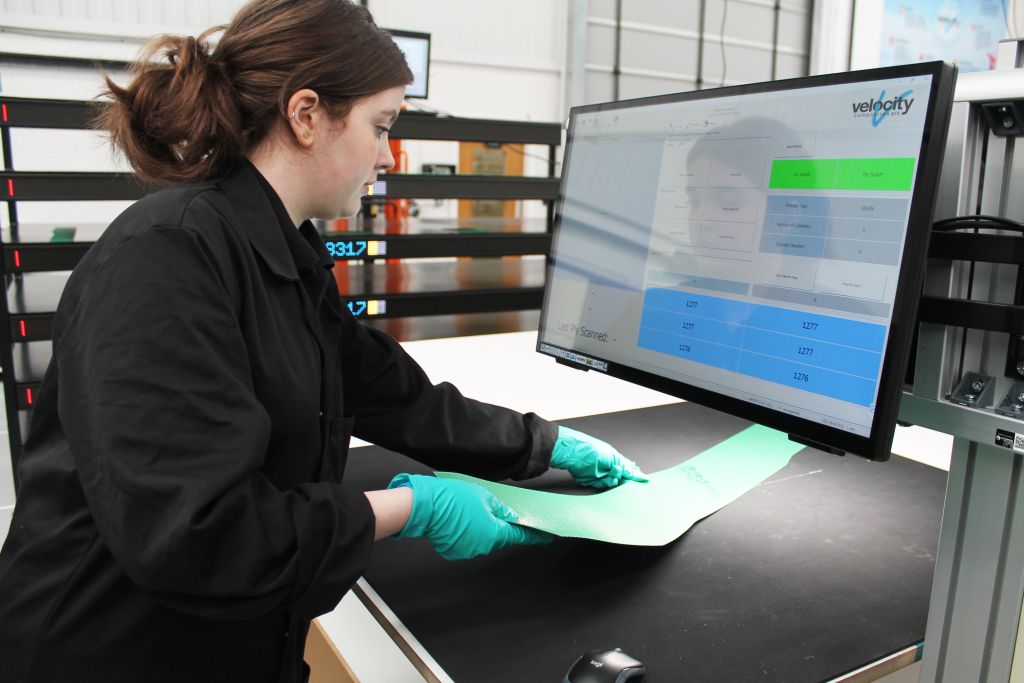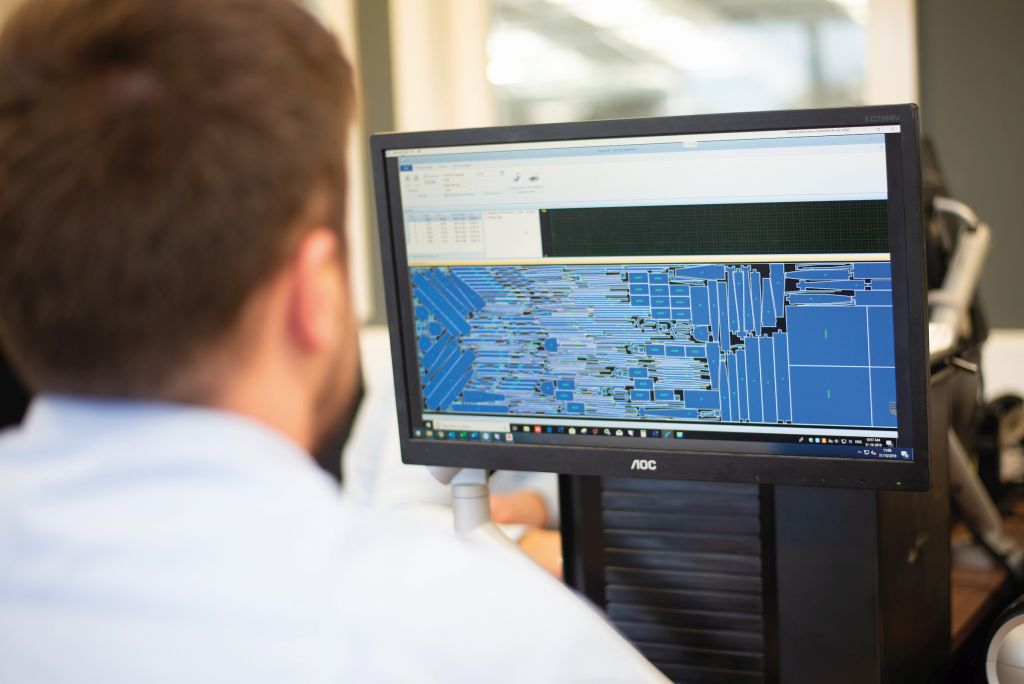More than just cutting shapes

The reliance on gathering data and using it to drive programmes in the supply chain has never been greater. Velocity Composites’ CEO, Jon Bridges looks at how Industry 4.0 can offer increased traceability and reduced waste.
The world of composites has never been smarter. The introduction of Industry 4.0 - as we are embracing it at our Velocity Composites’ manufacturing sites in the UK and US - allows us to manage product life as efficiently as possible, offer smarter solutions to supply chain management and kit cutting, and reduce material and operational waste by as much as 20%.
We aim to be at the forefront of harnessing the opportunity to change the way composite manufacturing is managed, so that we can streamline the process to be as efficient as possible. Indeed, we’re using the tenets and technology of Industry 4.0 to transform the composite supply chain.
We produce engineered structural and process material kits, predominantly to the aerospace sector. I have over 25 years’ experience building kits and have seen the industry shift and change to adapting to the changing market and developing technologies.
Since our inception, we have always been about more than just cutting shapes. We’ve used our in-house developed technology to ensure customers get the best value, by providing kits which reduce all forms of waste from the composites supply chain. Furthermore, our managed service allows companies to wholly remove the composite supplier management out of their supply chain, outsourcing the whole process to us where we can manage every step within our dedicated teams and digital processes, at the same time providing full traceability and creating operational savings and improvements in cashflow. The icing on the cake is the realised material savings from our demand management and nesting operations to produce the kits we supply just-in-time to our customers.

This allows our customers to focus on their core business of part manufacture and meet the global challenges around new aircraft programmes, aircraft production rate increases and the cost challenges around the volume growth in aerospace composite materials.
Our Enterprise Resource Planning (ERP) software is designed to wholly own every element of the composite supply chain so we can find efficiencies and reduce waste at every step. Our proprietary VRP and Hypernest systems range from advanced real-time nesting, batch control, life control, material utilisation reports, quality management, machine integration, change management and new product development-introduction.
We’ve also worked with some of the world’s leading equipment suppliers to develop our process machinery in line with our service offering to provide fully automated cutting beds and augmented digital identification systems for structural composite materials, plus dedicated equipment for welding and sewing process materials. As a result, Velocity’s customers have been able to reduce material waste by up to 20%, while also creating operational, stock and process efficiencies in a way which supports staff to be more effective.
Greater traceability
The need for full traceability in aerospace supply chains has never been greater. From project managing parts manufacture and supply to fit within a ‘Just in Time’ and ‘Just in Sequence’ production schedules, through to tracking the journey, lifespan and viability of individual products. Embracing Industry 4.0 gives us the tools to offer this high level of traceability and management in real-time.
Our mission is to make the aerospace composite supply chain as transparent and forward thinking as possible. Our proprietary software can now track the entire lifecycle of a material or ply from freezer storage to shopfloor to delivery, while additional processes, such as our new Digital Manufacturing Cell can reduce both material and operational costs.

The cell is the latest in a range of data-driven technological advances at Velocity, aimed at fully tracking and tracing the aerospace supply chain for customers, improving efficiencies, and making savings on material and operational costs.
Velocity’s own VRP technology has been designed to manage the entire value stream, from customer demand management, raw material management, batch traceability, complex nesting, kit manufacture and kit logistics, with all areas connected and sharing real-time data to drive maximum efficiencies.
Additionally, our software allows clients to benefit from real-time data which helps with resource planning from their initial acceptance and planning, through every step before it is delivered to optimise operations, cut down on waste and provide sound information upon which to make decisions.
As such, the Digital Manufacturing Cell was born out of a drive to reduce operational costs for customers and create a smart, lean manufacturing process. The cell combines our bespoke software with our fully automated 3-axis conveyor bed Zund cutting machines, along with a series of smart stacking, sequencing and packaging areas.
The cell allows every individual ply to be uniquely identified, against which its progress can be measured. The plies are then nested using our exclusive Hypernest software which ensures maximum use of materials and minimum waste when they are cut.
Following the ply cutting, our process combines automated visual inspection (AVISoCS) of every ply for unique verification together with pick-by-light technology for kit collation containing digital functionality to demonstrate and confirm kitting progress to both our operators and VRP system. This is all in place to augment the unbeatable dexterity of people during the manufacturing process and drive efficiency when running our significant length nests with multiple rolls.
The Modular Collation System (MCS) is made up of multiple kit locations in racks, being scalable to the required job size. Each MCS comprises 1,500 pitched LEDs which track in real-time the ply location and kit reference, together with completion progress feedback to VRP.
Following the collation, the product is numerically sequenced to reduce time at the customer’s end when unpacking the delivery, with each part available in the order it is needed for assembly.
In addition to providing customer benefits in traceability and efficiency, the technology which is inherent in the Digital Manufacturing Cell allows us to improve our own internal processes and realise significant increases in scale. We pride ourselves on minimal waste and ultimate efficiency, and this facility allows us to optimise our workflow, whilst managing cutting operations of individual nests that contain thousands of plies, managing each job flexibly and providing ultimate value to the customer.
Enhanced material shelf life
A key element of composite waste, and savings that can be made in the supply chain, are related to expired materials, and we use the latest software to manage and optimise material life to reduce waste.
Lack of tracking and management around times that structural and consumable kits are exposed to ambient temperatures can lead to product expiring and shorter usability time. This lack of information leads to disposed and wasted material either because it cannot be consumed in the required manufacturing lead-time, or it cannot meet the traceability criteria required in highly regulated industries such as aerospace.
With structural material kit supply, we are dealing with high-value, high-performance components such as fuselage, wing, engines nacelles and empennage sections built to high tolerance in a highly regulated process.
The raw material kits for these are manufactured in our clean room environment to manage usable life and protect from contamination. Due to the pre-impregnated resin, the raw material rolls are stored at -18°C in our on-site freezers to protect shelf life until they are needed for production.
Both the frozen and ambient life of our raw materials and finished parts are tracked in real-time at an individual roll and kit level, assisted by radio frequency identification technology (RFID) and digital systems for full ply level traceability, meaning we can accurately track the remaining life of raw materials to cut down on waste and provider greater traceability to customers.
Using the Velocity process with digital technology, we ensure there is total traceability of the materials in and out of the freezer, with a full history and audit of all movements, including batch numbers of the materials relating back to the parent roll and supplier backed by RFID technology. As such, our service ensures that a material is still well within specification when cut and supplied, reducing the risk of life expiry waste in turn.
Reducing operational waste
At the start of any structural kitting programme, the initial CAD data we are sent by our customers is often reconfigured by our Hypernest software to ensure correct formatting and to ensure the detailed design can be processed by our CNC cutting machines.
This reverse engineering step is necessary to create the correct software language across our process and is also fully traceable and utilises our Digital Ply Inspection platform to audit our engineering work and ensure all our shape data is fully compliant with the original customer data.
Similarly, our Hypernest software ensures maximum efficiency on the digital cutting tables, by ensuring that maximum material utilisation and minimum material wastage during the production run. This includes much larger and complex nests of shapes, some well over a kilometre in length, where the software identifies opportunities.
Rolls are only picked from frozen storage according to the customer demand and agreed operating principles to preserve their material shelf life. Once issued to our clean room, the software further identifies improved operational efficiency due to precise roll-size and required roll change-overs.
The digital symbiosis of our cutting equipment, Hypernest and VRP systems are paramount to allow real-time data updates for manufacturing operations performance and material utilisation efficiency, to not only ensure business performance is on-track, but further give our customers insight into our long-term service performance for our agreed contracts.
No limit to technology’s impact
There is no limit to where we can take this technology, backed up by the real-time data-driven processes which give us and our customers valuable information upon which to make decisions.
Indeed, as we continue to develop and refine our processes for increasing efficiencies on behalf of our customers and the wider supply chains, we believe other industries can benefit from this adaptive, flexible technology.
The processes and software at Velocity are not limited to the aerospace sector. The automotive, wind energy, sport and leisure industries are already looking at the possible opportunities. In the automotive industry, the parts are generally higher volume and continually changing due to continuous development, so the flexible, kitted solution is well suited and processes themselves are transferable.
The way this technology can be adapted and exploited to revolutionise composite supply chains across all sectors can ensure that the impact of 4.0 can continue unhindered.
At Velocity, our commitment to new industry techniques and own innovation in software development is already leading us to new sectors and geographies as we continue to grow and expand across Europe and US, supporting customers to make real improvements, changes and savings to make them more efficient and competitive.












